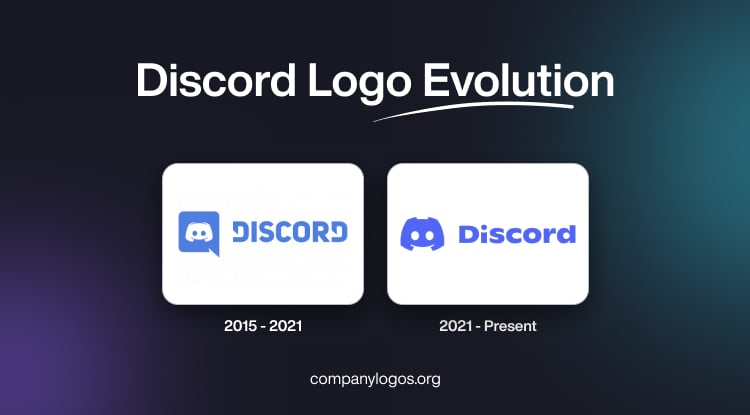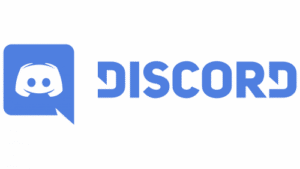
Discord, developed by Jason Citron and Stanislav Vishnevskiy, is an online messenger app available in thirty languages. It is used by a large section of users – gamers, students, music lovers and crypto enthusiasts. Since its launch in 2015, it has rapidly grown from a niche tool for gamers into a global communication platform for communities of all kinds. Central to its identity is its instantly recognisable logo, which has undergone just one change over the years. The article explores the logo changes for Discord since its inception.
The Genesis of the Discord Logo (2015 – 2021)
When Discord debuted in 2015, its logo was designed to be both simple and meaningful. It targeted the gaming community while signalling its core function as a chat platform. The original logo consisted of two main elements. To the left there was a stylised character named “Clyde” enclosed within a blue and white speech bubble. Clyde’s design was intentionally abstract and meant to resemble a game controller. It had arched grips that doubled as a smile and blue “joystick” eyes. This playful ambiguity led to some users seeing Clyde as a crab or another creature. However, its unique shape quickly became iconic within the gaming community.
To the right of the emblem, the word “DISCORD” appeared in a bold, blocky uppercase geometric sans-serif typeface to reinforce the platform’s modern and tech-forward image. The letters “D” at the front and end had their vertical bars cut diagonally. The blue and white colour palette of the logo provided a clean, approachable look. At the same time, the speech bubble clearly communicated the platform’s chat functionality.

(2021 – Present)
In May 2021, to mark its sixth anniversary, Discord unveiled a refreshed logo that aligned with contemporary design trends. In this logo variant, the speech bubble was dropped, which allowed Clyde to stand alone as the central icon. This shift made the logo more minimalistic and versatile and reflected Discord’s broader appeal beyond gaming.
The Clyde mascot was simplified and modernised and appeared in a vibrant custom blue-purple shade known as “Blurple”. Clyde’s design became more readable and visually impactful, and it better resembled a modern game controller while maintaining its friendly, smiley character. The wordmark was redesigned in a new, custom font based on the Ginto typeface. The updated style used small capitals, with only the first letter capitalised. It made the brand feel more approachable and contemporary.
The new logo colour scheme featured a brighter and more dynamic blurple. It enhanced the brand’s digital presence and made the logo stand out across devices and platforms.

The Elements of the Discord Logo
Font
The Discord wordmark is rendered in a customised sans-serif typeface in uppercase. The font is similar to traditional fonts, such as Compose Black or Uni Sans Heavy.
Colour
The colour palette employed by the Discord logo is a shade of blue-violet against a white background. Here, blue conveys reliability, safety, and trustworthiness, while white stands for purity, loyalty, and togetherness.
The History of Discord
Discord was founded in 2015 by Jason Citron and Stanislav Vishnevskiy, both of whom had extensive backgrounds in gaming and technology. Citron previously founded OpenFeint, a social gaming platform for mobile games, which was acquired by GREE in 2011. The app was created by recognising the limitations of existing voice and chat solutions for gamers.
The journey began in 2012 when Citron established Phoenix Guild (later Hammer & Chisel) to develop games that brought people together. Its first project, the mobile MOBA Fates Forever, included built-in chat features. These laid the groundwork for Discord’s eventual focus on seamless online communication. By May 2015, Citron and Vishnevskiy, after leveraging their experience from Fates Forever, released Discord. It was a free, gaming-focused chat app for desktop and mobile.
Discord quickly gained traction among gamers thanks to its easy-to-use interface, low-latency voice chat, and robust moderation tools. Within its first year, Discord had over 25 million registered users, with communities forming around popular games and streamers. Its appeal was further fuelled by features like custom servers, text and voice channels, and integrations with Twitch and YouTube.
In 2016, Discord introduced a PC in-game overlay, a friends list, and its first official API, which enabled third-party app integrations. Custom emoji and direct voice calls followed soon after. In 2017, the launch of Discord Nitro, a premium subscription, offered perks like animated avatars and global emoji use. Video chat and screen sharing were also introduced. These expanded Discord’s capabilities beyond voice and text.
Between 2018 and 2019, Discord raised significant funding, which included $150 million in December 2018. It also partnered with Microsoft to integrate with Xbox Live and broaden its reach to console gamers. In 2020, amid the COVID-19 pandemic, Discord’s usage surged as people sought ways to connect virtually. The company raised $100 million at a $3.5 billion valuation and announced a shift in focus from purely gaming to a more general communication platform. It also adopted the slogan “Your place to talk”.
During the period between 2024, Discord continued to innovate with features like PlayStation account linking, Activities (in-app games), soundboards, and voice messages. The platform also began powering in-game text and voice chat for select games. While the roots of Discord are in gaming, its flexible server and channel system attracted a diverse range of communities. These include artists, musicians, educators, and hobbyists. Its ability to host events, discussions, and collaborations made it a go-to platform for a wide array of groups.
Discord’s core features remain free, but the introduction of Discord Nitro provided a sustainable revenue stream. Nitro subscribers gain access to exclusive perks, such as higher-quality screen sharing, custom emojis, and server boosts. It supports both users and the platform’s growth.
Discord has become a staple in the online communication landscape and connects hundreds of millions of users worldwide. Its influence extends beyond gaming, and it serves as a virtual gathering place for communities of all kinds. The platform’s commitment to privacy, security, and user-centric design continues to drive its evolution and enduring popularity.
Interesting Facts About Discord
- Discord was developed by Jason Citron and Stan Vishnevskiy to enable talking while playing games. The two wanted to have a clear voice chat better than Skype or TeamSpeak.
- It was built using technologies such as Rust and React Elixir, which allow it to scale and handle millions of concurrent users.
- The various features of the app include video calling, channels with any topics, and screen sharing. These features were useful for working professionals, study groups, artists, and friends.
- Since its launch in 2015, Discord has experienced explosive growth. It had about 25 million registered users in 2016, which grew to over 560 million by 2023, with projections reaching around 656 million users in 2025.
- The voice chat technology used by Discord is called Opus codec, which is great for podcasting, gaming, and virtual meetings.
- Discord enables structured conversations using threads, slash commands, and bots. These features can be used for various things, such as AI integration, music, or moderation.
- Discord recorded approximately 200 million monthly active users in 2023, marking a 14.2% increase from the previous year. During the pandemic in 2020, the platform hit 100 million monthly active users, doubling from 56 million in 2019.
- In 2020, Discord reached a peak of 10.6 million concurrent users, surpassing its previous record of 8.2 million in 2018.
- Discord earns its revenue through Nitro subscriptions instead of traditional ads. These subscriptions offer features like better upload limits, higher-quality video, and custom emojis.
- The United States is the largest market for Discord, with nearly 229 million visits in July 2022. Other major markets include Brazil, France, the United Kingdom, and Germany.
- Discord requires users to be at least 13 years old to join, though this age limit varies by country depending on local laws.
- By 2023, Discord hosted approximately 21 million active servers, offering users highly customisable spaces for communities ranging from gaming to hobbies and professional groups.
- Although originally designed for gamers, Discord’s flexibility has attracted diverse communities, including artists, educators, and hobbyists. Non-gaming channels cover topics like TV shows, sports, study groups, and local communities.
- Discord offers features such as voice and video chat, screen sharing, custom roles and permissions, bots for automation, and integration with gaming consoles like Xbox and PlayStation, enhancing social gaming and community engagement.
- Discord’s premium subscription, Discord Nitro, provides users with perks like animated avatars, higher quality streaming, and server boosts, supporting the platform’s growth while keeping core features free.
- Discord has become a central hub not only for gaming but also for social interaction, collaboration, and creativity, redefining how people connect online around shared interests.
Finally
The evolution of the Discord logo shows the platform’s journey from a gaming-centric chat app to a universal hub for digital communities. Its transformation from a speech bubble with a playful mascot to a streamlined, modern icon demonstrates Discord’s adaptability and focus on clear, effective branding. Today, Clyde stands as a symbol of connection, creativity, and community in the digital age.